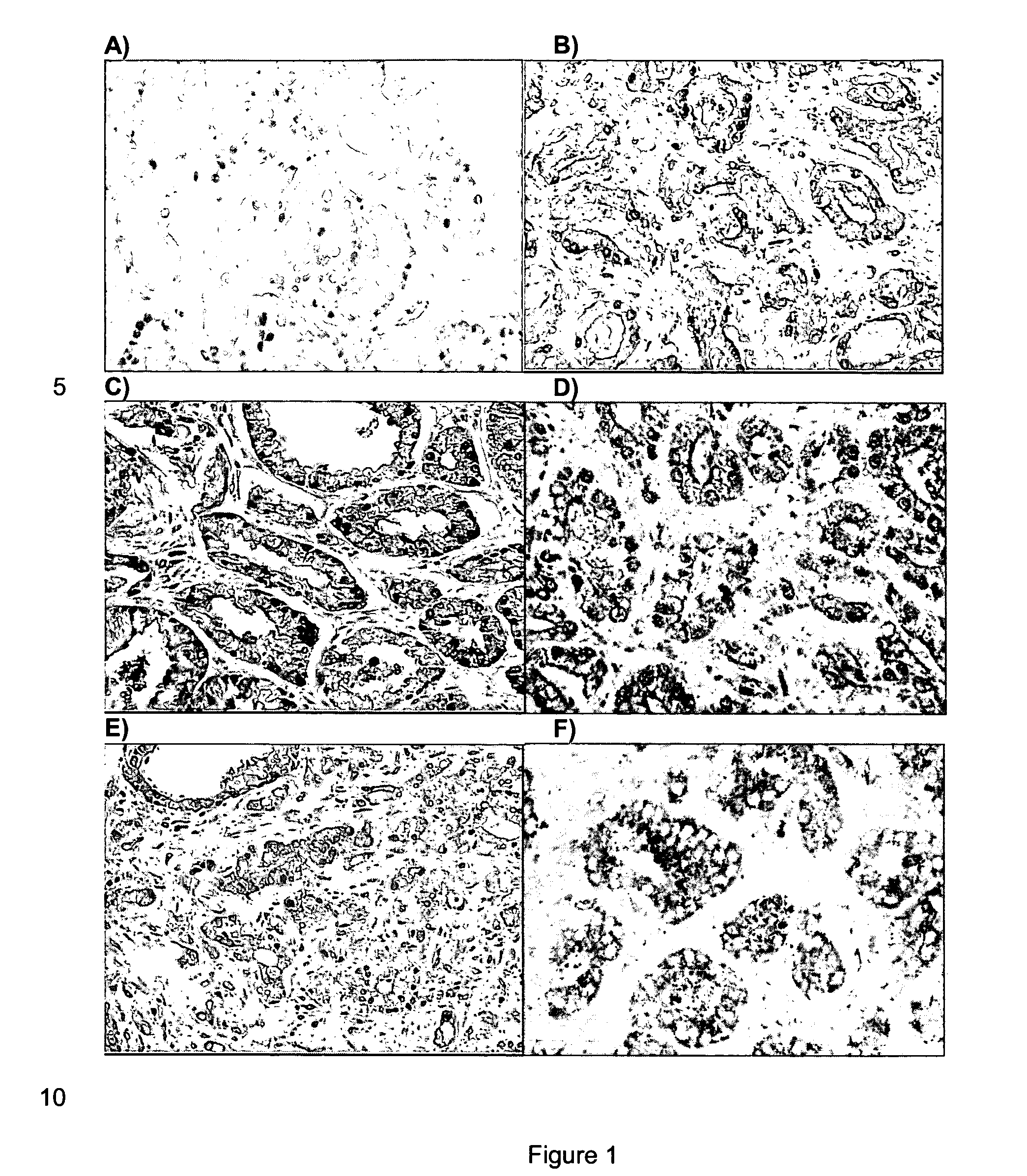Prognostic marker for prostate cancer and methods and kits for using same
a prostate cancer and prognostic marker technology, applied in the field of prognostic marker for prostate cancer and methods and kits for using same, can solve the problem of no known molecular marker that can predict the progression of prostate cancer, and achieve the effect of accurate prognosis
- Summary
- Abstract
- Description
- Claims
- Application Information
AI Technical Summary
Benefits of technology
Problems solved by technology
Method used
Image
Examples
example 1
[0024] NF-κB can Predict the Development of Prostate Cancer Bone Metastases
[0025] Detection of NF-κB(p65) in Prostate Cancer
[0026] In our first study, all 45 tumors demonstrated cytoplasmic staining and 18 / 45 tumors also had positive nuclear staining. NF-κB was detected in the cytoplasm of normal and tumor cells, but nuclear localization was observed only in cancer cells (example of p65 nuclear staining in FIG. 1a). In normal glands surrounding the tumors, basal cells had higher intensity of staining than luminal cells.
[0027] We tested whether nuclear NF-κB was linked to the degree of histological differentiation. Tumors were analyzed according to Gleason grade and were sub-divided into three groups. Nine tumors were well differentiated (Gleason scores 2-4), 24 showed moderate differentiation (Gleason scores 5-7), and 12 tumors were classified as poorly differentiated (Gleason scores 8-10). Although NF-κB nuclear staining was observed mainly in moderately and poorly differentiate...
example 2
[0033] NF-κB can Predict the Presence / Development of Prostate Cancer Lymph Node Metastases
[0034] Seventy-seven paraffin-embedded lymph node specimens obtained from 54 prostate cancer patients were analyzed. Of the 54 patients, 32 had positive lymph node metastases, while 22 showed no evidence of metastasis and were considered as controls. Nuclear localization of NF-κB was significantly greater in the metastatic lymph node group compared to controls. In patients with positive-lymph node metastases, 84.4% showed >10% nuclear staining in tumor cells. Moreover, 64.4% of the malignant lymph node specimens had >10% nuclear staining in lymphocytes compared to 0% in controls. Intensity of cytoplasmic and nuclear staining was higher in the metastatic lymph node group than in controls (p<0.01).
[0035] When comparing the 32 lymph node metastases with their corresponding primary prostate cancer tumors, we observed a concomitant up-regulation of nuclear NF-κB. This suggests that the constitutiv...
example 3
[0036] NF-κB can Predict Biochemical Relapse After Radical Prostatectomy
[0037] Radical prostatectomy is the most common treatment option for men with clinically localized disease. For those patients who manifest a pathological evidence of post-operative positive surgical margins (pT3), it is still controversial whether aggressive adjuvant treatment should be instituted or not. We examined the sub-cellular localization of NF-κB in tissues of pathologically proven prostate cancer with positive surgical margins of prospectively followed patients and correlated it with clinical outcome.
[0038] Four (4) years after surgery, patients with negative (5%) nuclear NF-κB tumors which has only a 38% chance of relapse (p=0.034). Overall, NF-κB sub-cellular localization is correlated with a biochemical relapse. This may help tailoring adjuvant therapy according to risk categories, in this group of patients for which any therapeutic decision is, up to now, controversial.
PUM
| Property | Measurement | Unit |
|---|---|---|
| surface area | aaaaa | aaaaa |
| RH | aaaaa | aaaaa |
| area | aaaaa | aaaaa |
Abstract
Description
Claims
Application Information
 Login to View More
Login to View More - R&D
- Intellectual Property
- Life Sciences
- Materials
- Tech Scout
- Unparalleled Data Quality
- Higher Quality Content
- 60% Fewer Hallucinations
Browse by: Latest US Patents, China's latest patents, Technical Efficacy Thesaurus, Application Domain, Technology Topic, Popular Technical Reports.
© 2025 PatSnap. All rights reserved.Legal|Privacy policy|Modern Slavery Act Transparency Statement|Sitemap|About US| Contact US: help@patsnap.com

